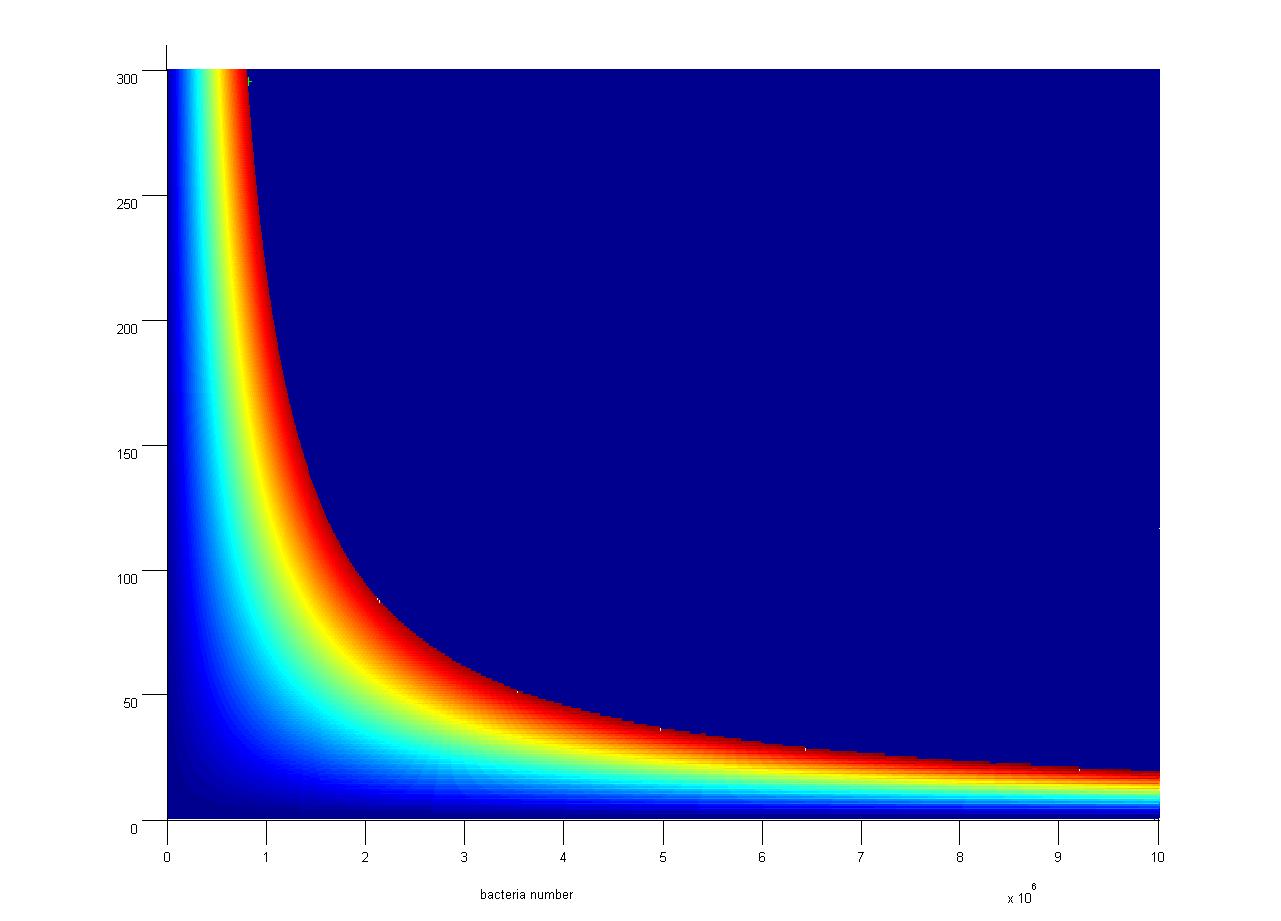Team:Aberdeen Scotland/parameters/invest 6
From 2009.igem.org
University of Aberdeen - Pico Plumber
Contents |
Quorum Sensing Activation Point
Calculating Steady State Concentration in Element of Water
When trying to model this system we often found ourselves asking; when does quorum sensing turn on? The closest we got to being able to find anything about this was Goryachev’s paper, ‘Systems analysis of a quorum sensing network’, which tried to model a quorum sensing network very similar to our own. He was able to say how many more molecules would be required inside the cell of HSL to turn the system on. From this we were able to calculate, knowing HSL’s diffusivity across the cell membrane, the outside concentration of HSL that this relates to, which is:
1.3372 x 10-5 M
It is possible to look at the differential equations in Goryachev’s model and calculate the steady state values of all the chemicals. Knowing the steady state level of HSL it is possible to then calculate how many molecules of HSL are coming out of each cell before quorum sensing is activated. According to the basal model (in which parameters were changed to make the model work), the steady state molecular flow out of the cell is:
49.9 molecules per second
We know the diffusion coefficient of the HSL molecule in water, and so by analysing what happens to a small volume of water containing bacteria producing HSL and making a lot of assumptions it is possible to estimate how many bacteria are required to turn on quorum sensing. The aim of this analysis is to solve the diffusion equation so that if we know the rate of production of a molecule by each bacteria, we can then calculate how many bacteria are required to sustain a given concentration in a given small volume, assuming the molecule is diffusing to an infinitely large space. The model also assumes the bacteria have adequate food source to continually produce signalling molecules at a constant rate.
To calculate the molecular flow out of our element of water we had to go back to the definition of the diffusion coefficient:
If we consider this case for a spherical element of fluid in an infinitely large reservoir of water so that the concentration of HSL outside the element may be considered to be zero, and that the partial derivative of concentration gradient is constant throughout the element, then this simplifies to:
Considering that the rate of change of moles coming in and out of the cell divided by the surface area, A, is the flux, F:
And through rearranging:
And so for this simplified and rather theoretical case, through the use of a MATLAB program to iterate over a large varying number of bacteria over a set amount of time, the number of bacteria in a spherical microlitre required for quorum sensing can be calculated.
Results of Program
Firstly to understand the results of the program it is best to understand how the program works. The user must specify for how long the program should calculate the HSL levels for each increasing number of bacteria. The graphical results of this, as you will see, show that there is a vertical asymptote at just below 1 million bacteria per microlitre. For some of the cases close to this asymptote where the bacteria can only just quorum sense it may take many hours, perhaps days, for quorum sensing to turn on. I decided that running this for 30 minutes would give a better estimate of the population for which quorum sensing turns on. It must be noted that the estimate for the concentration at which quorum sensing turns on from Goryachev's paper could be incorrect, as well as his estimate for the rate of production of HSL from each bacterium, but this does not invalidate the usefulness of this program in calculating how long it takes for a chemical to build up in an element of bacteria containing water.
In the above graph the bacteria number is plotted on the x axis, time on the y, and colour represents the concentration of HSL. The more red the colour is the closer the concentration is to the critical concentration for quorum sensing to be activated. The abrupt stop from red to blue shows where quorum sensing is activated, and the program stops.
Although the numbers inputted into the program could be incorrect, it could have further application for future iGEM teams and can be downloaded on our download page.
 Back to the Amended Model Back to the Amended Model
|
Continue to the Combined Model 
|
References
[1] Goryachev . Systems analysis of a quorum sensing network: Design constraints imposed by the functional requirements, network topology and kinetic constants. BioSystems 2006;83(2-3 SPEC. ISS.):178.
 "
"




